Blue Betta Fish Care, Tips and Tricks.
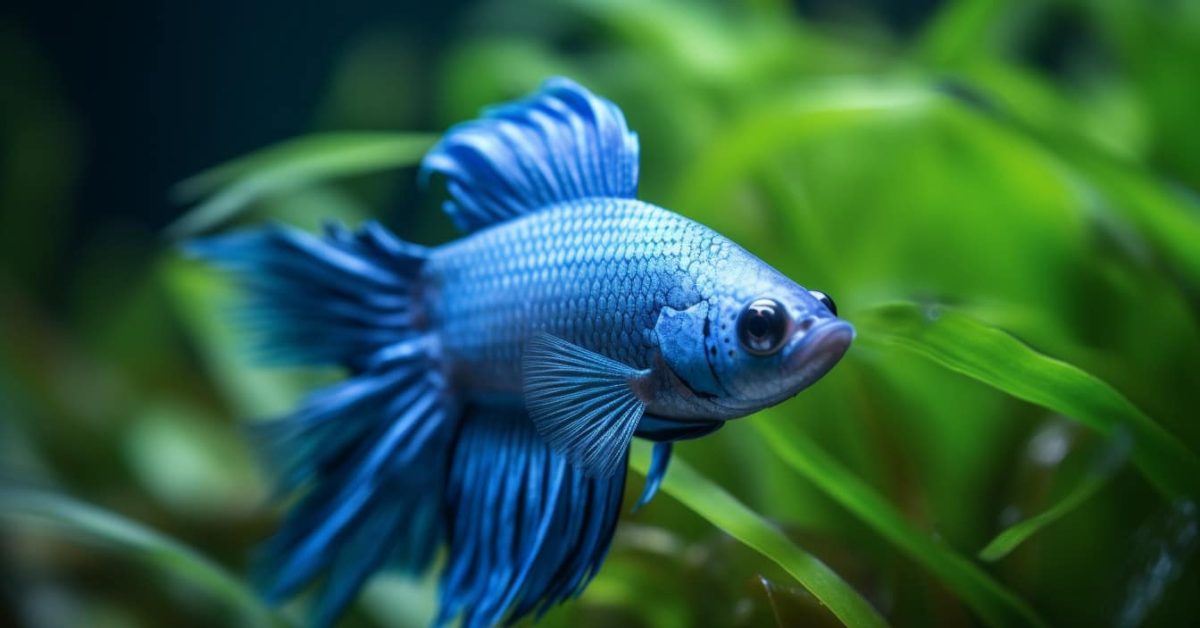
If you’re looking for a great pet to add to your aquarium, or just curious about the Blue Betta Fish’s cool personality, Stay close and keep scrolling.
If you’re looking for a great pet to add to your aquarium, or just curious about the blue betta fish’s cool personality, Stay close and keep scrolling.
The Blue Betta Fish, also known as the Siamese Fighting Fish is one of the most popular and great fish species in the world, their striking blue colors, variations, and flowing fins and tails make them a favorite among many fish keepers.
But what makes these fish so special? Let’s take a closer look at the unique characteristics of blue bettas and how to care for them.
In this article, we’ll dive into everything you need to know about these little finned friends, from what they like to eat to the perfect companions to swim with. We’ll even explore how to make some baby bettas if you’re feeling adventurous! Plus, we’ll cover some common health concerns and the best tanks to keep your bettas happy and healthy. So get ready to explore
Table of Contents
The Magic of Siamese Fighting Fish in Shades of Blue.
Blue bettas are popular ornamental fish due to their stunning and diverse shades of blue, ranging from deep navy to vibrant turquoise. They have also unique personalities and behaviors, like building bubble nests and flaring their colorful fins.
Blue bettas are known for their hardiness and ease of care, making them a great choice for both beginner and experienced fish owners.
Let’s talk about the fascinating world of blue betta fish! In this article, we’ll dive into everything you need to know about these little finned friends, from what they like to eat to the perfect companions to swim with. We’ll even explore how to make some baby bettas if you’re feeling adventurous! Plus, we’ll cover some common health concerns and the best tanks to keep your bettas happy and healthy.
So get ready to explore
The Fascinating Characteristics of Blue Betta Fish.
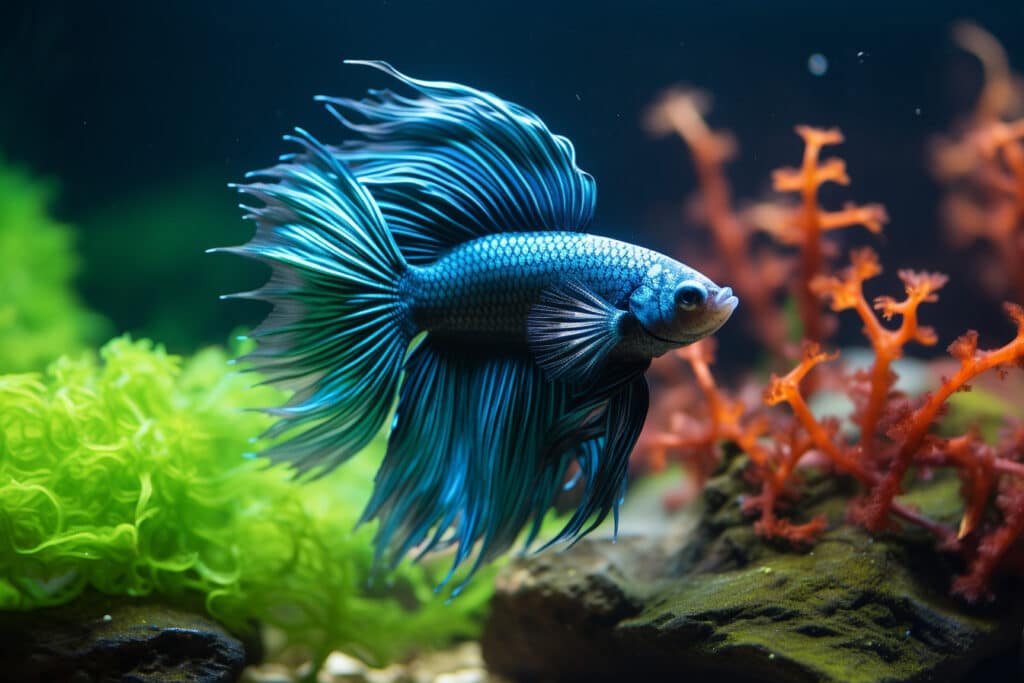
Betta fish are fascinating creatures, and their blue coloration is one of the many reasons why they’re so beloved. But what makes these fish blue?
Blue Betta Fish Attitude.
The temperament of blue betta fish can vary from individual to individual, but they are generally known for their peaceful and non-aggressive behavior. They are also known to be curious and interactive with their owners, making them a great pet for those who want a fish with personality. However, it’s important to note that male bettas may exhibit more territorial and aggressive behavior, especially towards other male bettas.
The Reasons Behind The Blue Color in Betta.
Betta fish come in a variety of beautiful colors, but there’s something special about the blue ones. The blue color in betta is caused by a combination of genetics and special pigments called chromatophores, which are found in the skin of the fish. One specific type of chromatophore called iridophore contains reflective plates that scatter and reflect light to create a mesmerizing blue color.
Interestingly, the intensity of the blue color can also be affected by the lighting in the tank, making it appear brighter or darker depending on the environment. Another cool fact is that male bettas with blue coloration are often highly sought after for breeding, as the blue color can be passed down to their offspring.
The Physical Traits of Blue Betta Fish.
Blue betta fish have various physical characteristics that make them stand out in an aquarium. They have a streamlined body that can reach up to 3 inches in length.
Their scales are iridescent, which means they appear to change color depending on the light, giving them a unique and mesmerizing look.
Additionally, male blue bettas have longer, more vibrant fins and striking pigmentation than females making them a popular aquarium fish for aquarists.
What Sets tThe Blue Betta Apart?
Blue betta fish differ from other types of betta fish primarily in their coloration. While other types of betta fish come in a wide range of colors, including red, green, yellow, and black, blue bettas have a striking blue hue that sets them apart. Additionally, blue bettas can have different shades of blue, such as sky blue, royal blue, and navy blue. Their physical characteristics, such as body shape and fin type, may also vary slightly from other betta fish, but it is primarily their unique blue coloration that distinguishes them.
The Different Shades of Blue.
Blue betta fish come in various shades of blue, from light pastel blue to dark navy blue. Some blue bettas even have a metallic or iridescent shine to their scales, which can make them appear to have a silver or turquoise hue.
Additionally, some blue bettas have patterns or variations in their color, such as marbling or butterfly patterns, which add to their unique appearance. The exact shade and pattern of a blue betta can depend on a variety of factors, including genetics, environment, and selective breeding. Regardless of the shade or pattern, blue bettas are always a stunning and captivating addition to any aquarium.
Become a Betta Whisperer, Tips and Tricks for Keeping Your Blue Betta Fish Happy and Healthy. Ready to become a proud owner of a blue betta fish? Great! But before you bring your new pet home, let’s dive into the world of fishkeeping and learn how to properly care for your little buddy.
Tips For Setting Up a Suitable Betta Fish Tank.
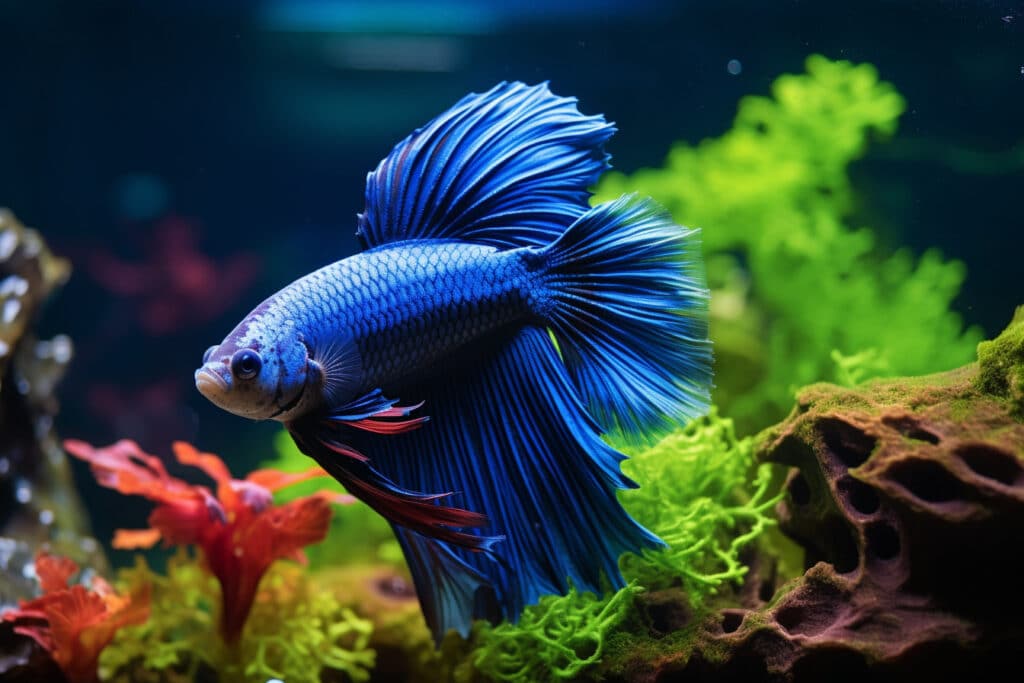
So you want to create a little paradise for your blue betta fish? Great idea! But where do you start? Don’t worry, we’ve got you covered with some helpful tips and tricks for setting up a tank that your fish will love.
Going Back to Betta Fish's Roots.
Betta fish, also known as Siamese fighting fish, are tropical fish that are native to the rice paddies and slow-moving streams of Southeast Asia. Their natural habitat is warm and humid, with a water temperature ranging from 75-82°F.
In the wild, bettas are used to living in shallow waters with plenty of vegetation, which provides them with shelter and food sources. They are also known for their territorial behavior and aggressive nature towards other fish. Overall, if you want to provide the best care for your pet blue betta fish, it’s important to understand their native habitat and replicate it as closely as possible in your aquarium.
If you’re planning to bring home a blue betta fish, setting up a suitable tank for them is crucial to their health and happiness.
Betta fish tanks come in all shapes and sizes, While they can technically survive in smaller tanks, it’s recommended to have a minimum tank size of 5 gallons in size, 10 gallon or larger tank is even better, as they offer more room to decorate and add live plants, just make sure to provide enough space for your betta to swim around comfortably and explore, which can help reduce stress and encourage healthy behavior.
In addition to the tank size, it’s important to consider the betta tank shape, Betta fish need access to the water surface to breathe, so make sure your tank is wide rather than high, to provide enough surface area for your pet fish to easily access air.
The Best Water Conditions for Your Blue Betta Fish.
To keep your blue betta fish happy and healthy, it’s essential to maintain proper water conditions in their tank. The best way to do so is regularly monitoring the water quality.
- Filtration – It’s important to remove any uneaten food and waste from the tank to prevent it from rotting and polluting the water using a Filtration system will help keep the water clean, just remember, the Filtration system is not enough by itself, carrying out regular water changes.
- pH Level – Maintaining a consistent pH level is crucial, as bettas prefer slightly acidic water with a pH between 6.5 and 7.5. will be just fine.
- Water Temperature – You should keep an eye on the water temperature in your aquarium and ensure it remains between 76 and 82 degrees Fahrenheit.
- Air Pumps – An air pump is an optional accessory for betta tanks that can provide additional aeration to the water. While bettas are labyrinth fish and can breathe air from the water’s surface, an air pump can still be beneficial for improving the overall oxygenation of the water. This is especially important if the tank is heavily planted or if other fish are sharing the tank. An air pump can also create gentle water movement, which can be beneficial for bettas.
- Live Plants – Adding live plants to your aquarium not only adds aesthetic value but also provides your fish with a natural hiding place. Betta fish love to explore and hide in their environment and live plants offer them just that. They can also help maintain water quality by absorbing nitrates and providing oxygen, Some great live plant options for betta fish include Java Fern, Anubias, and Amazon Sword. Just be sure to properly research each plant’s specific care needs before adding it to your tank.
- Light – The amount of light your tank gets can also impact your betta fish’s well-being, so make sure to choose a suitable location that provides enough light or shade for your fish’s needs.
In conclusion, setting up a suitable betta tank is essential for ensuring the health and happiness of your blue betta fish. It’s important to choose an appropriately sized tank that is wide rather than high, Additionally, make sure to maintain your tank regularly to keep the water clean and healthy for your blue pet.
With these tips, you can create a comfortable and inviting environment for your betta fish to thrive in!
Feeding Your Blue Betta Fish.
Betta fish have a diverse diet that includes live and freeze-dried foods.
Betta fish eat insects in the wild, so they enjoy freeze-dried or live food such as insect larvae. Betta fish also enjoy flake food and can be fed a combination of both freeze-dried and flake food.
It’s important not to overfeed your betta fish, as uneaten food can quickly pollute the water. A good rule of thumb is to feed your blue betta fish one or two small meals a day, with a total of three to five pellets per meal, depending on the size of the pellets. Remember, a Healthy diet will help keep your betta fish happy and vibrant!
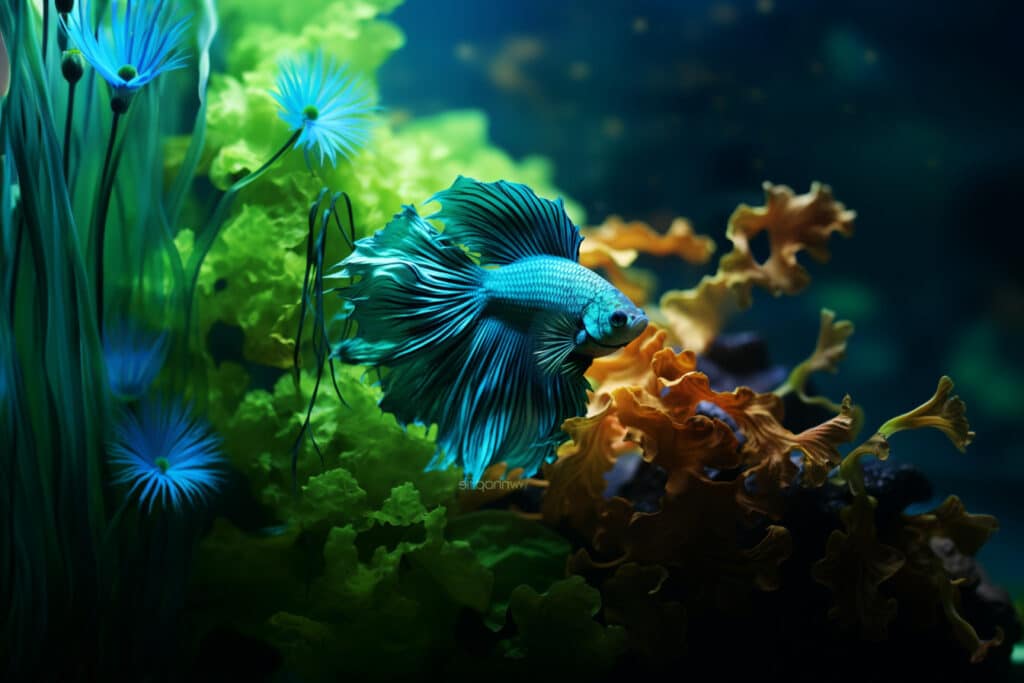
Blue Betta Tank Mates.
Betta fish are pretty aggressive and usually prefer to be alone in their tank. But if you have a big enough tank (10 gallons or more), you can add some other fish as tank mates. It’s called a community tank!
Some of the fish that can live with bettas include neon tetras, cory catfish, and guppies. Just make sure you don’t add any fish that are too colorful or have long fins in the same tank with your betta because he might mistake them for another betta and attack them.
Breeding Blue Betta Fish.
Ready to take your love for blue betta fish to the next level? Breeding these gorgeous fish can be a fulfilling hobby, but it’s important to understand the process and requirements for success. Let’s dive in!
Choose The Right Male and Female Fish for Breeding.
Breeding blue betta fish can be an exciting and rewarding experience for any aquarium enthusiast. To start with, you’ll need a male betta and one or more female bettas to form a breeding pair.
The first step is to condition the breeding pair by feeding them high-quality protein-rich foods and keeping them in separate tanks for a few weeks. When they’re ready, place the male and female bettas in the same tank, and wait for the magic to happen.
The male betta will start to build a bubble nest, which is a mass of bubbles on the water’s surface, to attract the female betta. When the female is ready to lay her eggs, she’ll approach the male, and the two will engage in a beautiful courtship dance.
After breeding is complete, the female should be removed from the tank to prevent the male from becoming aggressive towards her. The male will then take care of the eggs and fry, and the process of raising the fry will begin
Caring for the blue Siamese fighting fish can be a fascinating and rewarding hobby, and watching the male fish guard his bubble nest and fry is an experience unlike any other.
Common Health Issues And How to Treat Them.
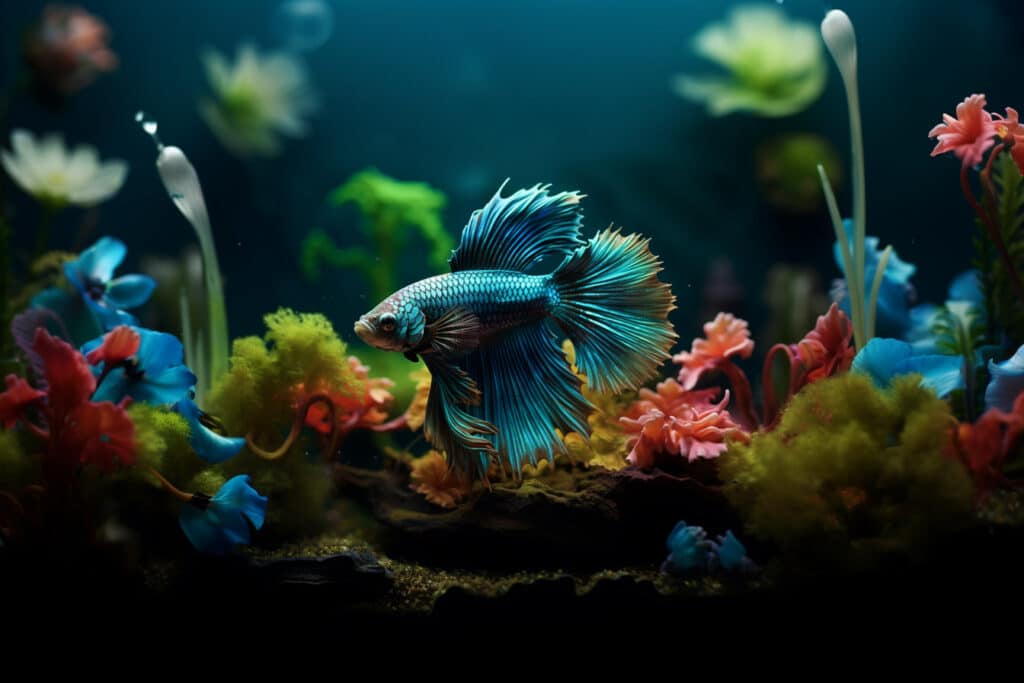
Blue betta fish, like all living creatures, can experience health issues. One of the most common health issues in bettas is fin rot, which is characterized by the deterioration of the fins. Other health issues include swim bladder disease, dropsy, and ich. It’s important to monitor your betta’s behavior and appearance regularly, as early detection can im
Blue betta fish, like all living creatures, can experience health issues. One of the most common health issues in bettas is fin rot, which is characterized by the deterioration of the fins.
Other health issues include swim bladder disease, dropsy, and ich. It’s important to monitor your betta’s behavior and appearance regularly, as early detection can improve the chances of successful treatment.
Treatment options include water changes, aquarium salt, and medication. Additionally, maintaining a clean and suitable environment, including proper water conditions and diet, can prevent many health issues in blue betta fish.
If you notice any concerning symptoms in your betta, it’s best to consult with a veterinarian or a knowledgeable aquarium specialist for treatment advice.
prove the chances of successful treatment. Treatment options include water changes, aquarium salt, and medication. Additionally, maintaining a clean and suitable environment, including proper water conditions and diet, can prevent many health issues in blue betta fish. If you notice any concerning symptoms in your betta, it’s best to consult with a veterinarian or a knowledgeable aquarium specialist for treatment advice.
How Long Do Blue Betta Fish Live?
Let’s start with the main question, The average lifespan of a blue Betta fish is 2 to 4 years. However, with proper care, the maximum lifespan can be up to 5 years or longer. It is important to provide your Betta with clean water and an appropriate diet that includes high-quality food specifically formulated for Bettas. Additionally, regular partial water changes are recommended
In conclusion, blue betta fish can be a wonderful addition to any home aquarium. Provide them with the right conditions to thrive and ensure your Betta’s health and longevity.
Blue bettas are fascinating creatures that offer a unique and rewarding pet-owning experience.
With their brilliant colors and flowing fins, they are not only visually stunning but also have distinct personalities that make them a joy to watch and care for.
From setting up their ideal tank environment to feeding them a varied diet and keeping them healthy, the process of caring for bettas can be both challenging and fulfilling.
Whether you are a first-time fish owner or an experienced aquarist, a blue betta fish is a great choice for anyone looking to add a touch of beauty and personality to their home.
We just talked about how to look after your blue betta fish! We covered the important things like how big the tank should be, what sort of food they like to eat and when to feed them, who they can hang out with in their tank, how to breed them if you want some cute little fish fry, and also what to do if your fish isn’t feeling too good.
Thank you for taking the time to read this article about blue betta fish. With proper care and attention, their colors will shine brighter than ever, and their personalities will bring a joyful presence into your life.
Related Blog Posts:
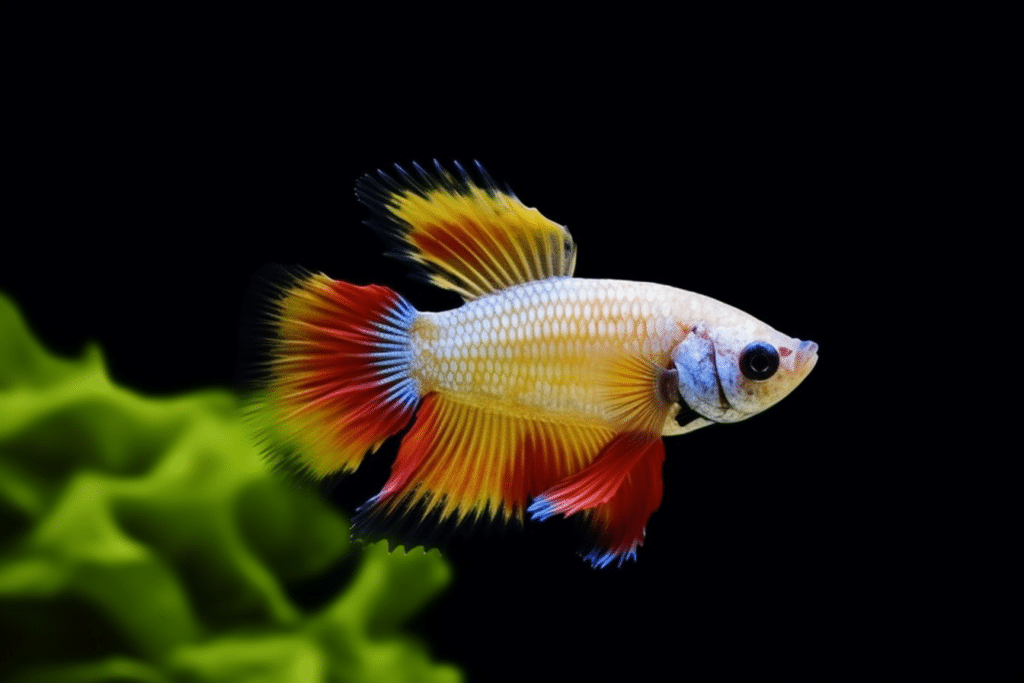
Discover Plakat Betta Fish Aquatic Elegance
Home Discover Plakat Betta Fish Aquatic Elegance Welcome to the captivating world of Plakat Betta
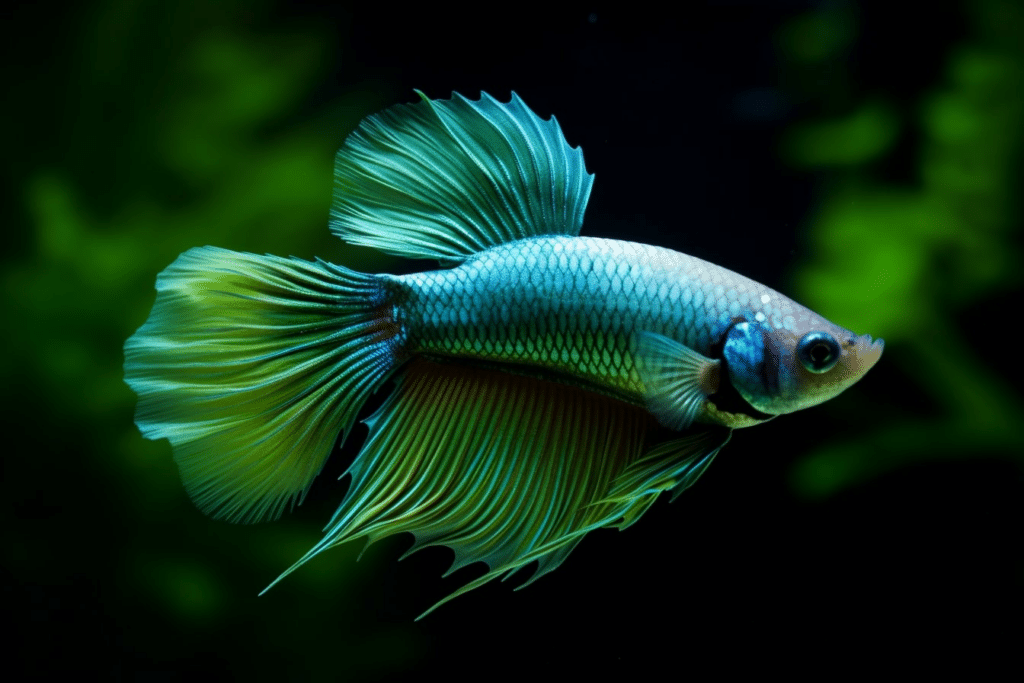
Green Betta Fish
Exploring the World of Green Betta Fish Welcome to our blog post all about green
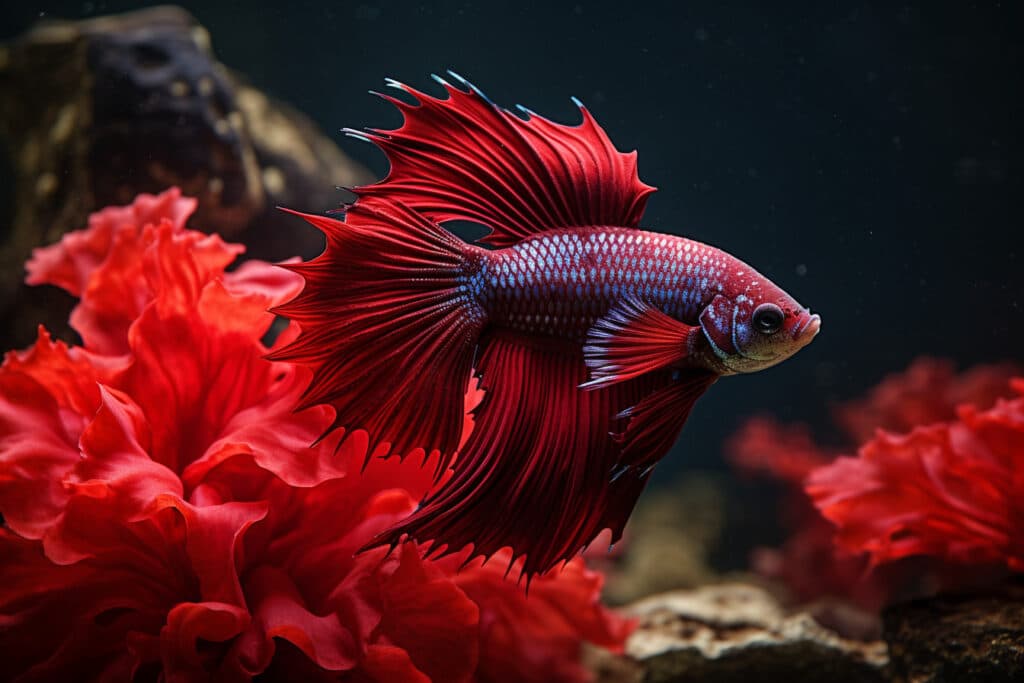
Red Betta Fish
Awesome Red Betta Fish Breeding Tips Red betta fish are like little gems swimming around
